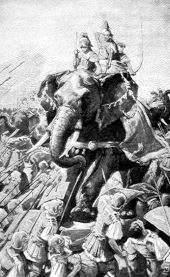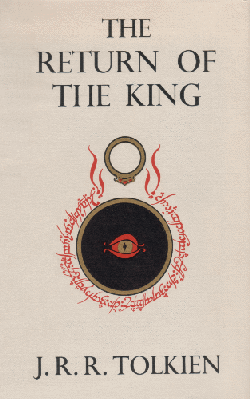In the fiction
Creation
The race of Men in J. R. R. Tolkien's fictional world, in his books The Hobbit , The Lord of the Rings and The Silmarillion , is the second race of beings, the "younger children", created by the One God, Ilúvatar. Because they awoke in the First Age at the start of the Years of the Sun, long after the Elves, the Elves called them the "afterborn", or in Quenya the Atani, the "Second People". Like Elves, Men first awoke in the East of Middle-earth, spreading all over the continent and developing a variety of cultures and ethnicities. Unlike Tolkien's Elves, Men are mortal; when they die, they depart to a world unknown even to the godlike Valar. [1]
Free peoples
Men are one of the four "free peoples" in the list-poem spoken by the Ent Treebeard; the others being Elves, Dwarves, and Ents. [T 1] Hobbits, not included on that list, were a branch of the lineage of Men. [T 2] [T 3] [T 4] Hobbits were not known to the Ents, but on meeting Merry and Pippin, Treebeard at once worked that people into the list. [T 1]
The concept of the free peoples is shared by Elrond. [T 5] The Tolkien scholar Paul H. Kocher writes that, in the style of the medieval Great Chain of Being, this list places Men and the other speaking peoples higher than the beasts, birds, and reptiles which he lists next. "Man the mortal, master of horses" is listed last among the free peoples, who were created separately. [6]
Diversity

Although all Men in Tolkien's legendarium are related to one another, there are many different groups with different cultures. Those on the side of the hobbits in The Lord of the Rings are the Dúnedain, the men who fought on the side of the Elves in the First Age against Morgoth in Beleriand, from whom other friendly groups, the Rangers including Aragorn, and the men of Gondor are descended; and their allies the Rohirrim. [1]


The main human adversaries in The Lord of the Rings are the Haradrim and the Easterlings. [1] The Haradrim or Southrons were hostile to Gondor, and used elephants in war. Tolkien describes them as "swart", [4] meaning "dark-skinned". [9] The Easterlings lived in Rhûn, the vast eastern region of Middle-earth; they fought in the armies of Morgoth and Sauron. Tolkien describes them as "slant-eyed"; [4] they ride horses or wagons, leading to the name "wain-riders". [1] The Variags of Khand formed a third but smaller group, who appear as vassals of Mordor in the Battle of the Pelennor Fields. Their name is from Russian : Варяги (Variag), meaning the Varangians, Viking or other Germanic warriors who served as mercenaries. [1] Other human adversaries include the Black Númenóreans, good men gone wrong; [10] and the Corsairs of Umbar, rebels of Gondor. [11]
| Nation/group | Culture | Language | Real-world analogues |
|---|---|---|---|
| Bree [T 6] | Village; agriculture; houses of wood, earth, stone | Westron | Medieval England [12] |
| Beornings [T 7] | Wooden hall; beekeeping, dairy | Westron | Norse myth (Bödvar Bjarki); Beowulf [13] |
| Dale [T 8] | Towns, trade, taverns | their own | Germanic medieval Europe |
| Drúedain [T 9] [T 10] Wild men, [T 10] Púkel-men, [T 9] Woses [T 10] | Forest | their own | Wild man legends of medieval Europe [14] |
| Dunlendings [T 11] Wild men of Dunland | Agriculture | Westron, Dunlendish | Celtic Britons [15] |
| Easterlings [T 12] People of Rhûn, Wainriders | Horses, war-wagons | their own | Huns [16] |
| Gondor and the Dúnedain [T 13] | Cities, stone architecture; literature, music | Westron, Sindarin, Quenya | Byzantine Empire, [17] Ancient Egypt, [18] Goths, [17] Langobards [17] |
| Haradrim [T 14] Southrons | Desert; war-elephants; raiding in ships | their own | Enemies of Ancient Rome [8] |
| Riders of Rohan [T 15] | Wooden mead-halls, agriculture, horsemanship | Rohirric, Westron | Anglo-Saxons, Goths [19] |
| Variags of Khand [T 16] | Mercenaries | their own | Varangians [1] |
Sandra Ballif Straubhaar notes in The J. R. R. Tolkien Encyclopedia that Faramir, son of the Steward of Gondor, makes an "arrogant" [1] speech, of which he later "has cause to repent", [1] classifying the types of Men as seen by the Men of Númenórean origin at the end of the Third Age; she notes, too, that his taxonomy is probably not to be taken at face value. [1]
| High Men Men of the West Númenóreans | Middle Men Men of the Twilight | Wild Men Men of the Darkness |
|---|---|---|
| The Three Houses of Edain who went to Númenor, and their descendants | Edain of other houses who stayed in Middle-earth; they became the barbarian nations of Rhovanion, Dale, the House of Beorn, and the Rohirrim. | All other Men, not connected to the Elves, including Easterlings and Dunlendings. [1] [lower-alpha 1] |
History
In a world with other intelligent and cultured races, Men in Middle-earth interact with each other and with the other races in a complex history, narrated mainly in The Silmarillion . Men are in general friendly with the other free peoples, especially Elves; they are implacable enemies of the enslaved peoples, especially Orcs. In the First Age, Men, the Edain, lived in Beleriand on the extreme West of Middle-earth. They form an alliance with the Elves and join a disastrous war against the first Dark Lord, Morgoth, which destroys Beleriand. As a reward for fighting in the war, the creator, Eru Iluvatar, gives the Edain the new island of Númenor as their home. [20] [T 17]
The key difference between Men and Elves now becomes central to the story: Elves are immortal, and return to Valinor, home of the godlike Valar, when they become weary of Middle-earth, or are killed in battle. Men, however, are mortal. [21] [22] Morgoth's servant, Sauron, tempts the Men of Númenor to attack Valinor, in their search for immortality: Sauron has falsely insinuated that Men can become immortal just by being in that place. The Men and Númenor are destroyed: the island is drowned, Atlantis-like, beneath the waves; the world is made round; and Valinor is removed from the world so as to only be accessible by the Elves. Sauron's body is destroyed, but his spirit escapes to become the new Dark Lord of Middle-earth. A remnant of the Men of Númenor who remained faithful, under Elendil, sail to Middle-earth, where they found the kingdoms of Arnor in the North and Gondor in the South, remaining known as the Dúnedain, "Men of the West". Arnor becomes fragmented, and declines until its kings become Rangers in the wilds, but they retain their memory of Númenor or "Westernesse", through many generations down to Aragorn, a protagonist in The Lord of the Rings. The line of kings in Gondor eventually dies out, and the country is ruled by Stewards, the throne empty, until Aragorn returns. [20] [T 17]
Intermarriage and immortality
Tolkien stated that the core theme of The Lord of the Rings was death and the human desire to escape it. [T 18] [T 19] The theme, which recurs throughout the work, is sharply visible in an appendix, "The Tale of Aragorn and Arwen", in which the immortal Elf Arwen chooses mortality so that she can marry the mortal Man Aragorn. The result, as with the earlier intermarriage of their ancestors Lúthien and Beren in the First Age in Beleriand, was to make Aragorn's line exceptionally long-lived among Men, and as the royal family intermarried with other people of Gondor, to maintain or extend the lifespan of the entire race. [T 20] [23] [24] [25]
Fading

The overall feeling in The Lord of the Rings, however, despite the victories and Aragorn's long-awaited kingship and marriage, is of decline and fall, echoing the view of Norse mythology that everything will inevitably be destroyed. [28] As the Tolkien scholar Marjorie Burns put it, "Here is a mythology where even the gods can die, and it leaves the reader with a vivid sense of life's cycles, with an awareness that everything comes to an end, that, though [the evil] Sauron may go, the elves will fade as well." [29] This fits with Tolkien's equation of Middle-earth with the real Earth at some distant epoch in the past, and with his apparent intention to create a mythology for England. He could combine medieval myths and legends, hints from poems and nearly-forgotten names to build a world of Wizards and Elves, Dwarves, Rings of Power, Hobbits, Orcs, Trolls and Ringwraiths, and heroic Men with Elvish blood in their veins, and follow their history through long ages, provided that at the end he tore it all down again, leaving nothing, once again, but dim memories. By the end of The Lord of the Rings, the reader has learnt that the Elves have left for the Uttermost West, never to return, and that the other peoples, Dwarves, Hobbits, Ents and all the rest, are dwindling and fading, leaving only a world of Men. [27] [29] [23]
Kocher writes that the furthest look into Man's future in The Lord of the Rings is the conversation between the Elf Legolas and the Dwarf Gimli, close friends, at the moment when they first visit Minas Tirith, the capital city of the Men of Gondor, "and see the marks of decay around them". [30] Gimli says that the works of Men always "fail of their promise"; Legolas replies that even if that's so, "seldom do they fail of their seed", in marked contrast to the scarcity of children among Elves and Dwarves, implying that Men will outlast the other races. Gimli suggests again that Men's projects "come to naught in the end but might-have-beens". Legolas just replies "To that the Elves know not the answer". [30] [T 21] Kocher comments that this "sad little fugue" is at variance with the hopeful tone of the rest of the work, remaining cheerful even in the face of apparently insuperable odds. [30]






